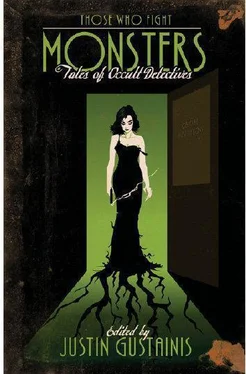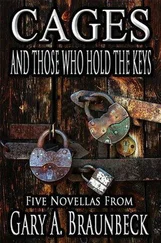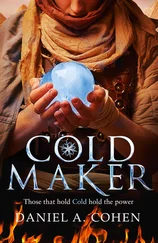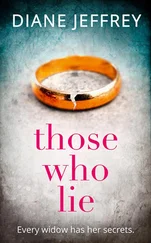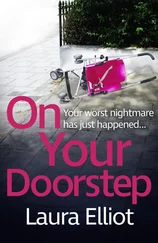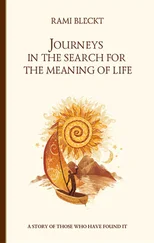Hardin stepped away from the closet, caught her breath, and tried to set the scene for herself. She couldn’t assume right away that the victim lived in the house. But maybe she had. She was almost certain the murder had happened somewhere else, and the body moved to the utility closet later. The closet didn’t have enough room for someone to cut a body through the middle, did it? The murderer would have needed a saw. Maybe even a sword.
Unless it had been done by magic.
Her rational self shied away from that explanation. It was too easy. She had to remain skeptical or she’d start attributing everything to magic and miss the real evidence. This wasn’t necessarily magical, it was just odd and gruesome. She needed the ME to take a crack at the body. Once they figured out exactly what had killed the victim — and found the rest of the body — they’d be able to start looking for a murder weapon, a murder location, and a murderer.
The half body looked slightly ridiculous laid out on a table at the morgue. The legs had been stripped, and a sheet laid over them. But that meant the whole body was under the sheet, leaving only the waist and wound visible. Half the stainless steel table remained empty and gleaming. The whole thing seemed way too clean. The morgue had a chill to it, and Hardin repressed a shiver.
“I don’t know what made the cut,” Alice Dominguez, the ME on the case, said. “Even with the burning and corrosion on the wound, I should find some evidence of slicing, cutting movements, or even metal shards. But there’s nothing. The wound is symmetrical and even. I’d have said it was done by a guillotine, but there aren’t any metal traces. Maybe it was a laser?” She shrugged, to signal that she was reaching.
“A laser — would that have cauterized the wound like that?” Hardin said.
“Maybe. Except that it wasn’t cauterized. Those aren’t heat burns.”
Now Hardin was really confused. “This isn’t helping me at all.”
“Sorry. It gets worse. You want to sit down?”
“No. What is it?”
“It looks like acid burns,” Dominguez said. “But the analysis says salt. Plain old table salt.”
“Salt can’t do that to an open wound, can it?”
“In large enough quantities, salt can be corrosive on an open wound. But we’re talking a lot of salt, and I didn’t find that much.”
That didn’t answer any of Hardin’s questions. She needed a cigarette. After thanking the ME, she went outside.
She kept meaning to quit smoking. She really ought to quit. But she valued these quiet moments. Standing outside, pacing a few feet back and forth with a cigarette in her hand and nothing to do but think, let her solve problems.
In her reading and research — which had been pretty scant up to this point, granted — salt showed up over and over again in superstitions, in magical practices. In defensive magic. And there it was. Maybe someone thought the victim was magically dangerous. Someone thought the victim was going to come back from the dead and used the salt to prevent that.
That information didn’t solve the murder, but it might provide a motive.
Patton was waiting at her desk back at the station, just so he could present the folder to her in person. “The house belongs to Tom and Betty Arcuna. They were renting it out to a Dora Manuel. There’s your victim.”
Hardin opened the folder. The photo on the first page looked like it had been blown up from a passport. The woman was brown- skinned, with black hair and tasteful makeup on a round face. Middle-aged, she guessed, but healthy. Frowning and unhappy for whatever reason. She might very well be the victim, but without a face or even fingerprints they’d probably have to resort to DNA testing. Unless they found the missing half. Still no luck with that.
Ms. Manuel had immigrated from the Philippines three years ago. Tom and Betty Arcuna, her cousins, had sponsored her, but they hadn’t seemed to have much contact with her. They rented her the house, Manuel paid on time, and they didn’t even get together for holidays. The Arcunas lived in Phoenix, Arizona, and this house was one of several they owned in Denver and rented out, mostly to Filipinos. Patton had talked to them on the phone; they had expressed shock at Manuel’s demise, but had no other information to offer. “She kept to herself. We never got any complaints, and we know all the neighbors.”
Hardin fired up the Internet browser on her computer and searched under “Philippines” and “magic.” And got a lot of hits that had nothing to do with what she was looking for. Magic shows, as in watch me pull a rabbit out of my hat, and Magic tournaments, as in the geek card game. She added “spell” and did a little better, spending a few minutes flipping through various pages discussing black magic and hexes and the like, in both dry academic rhetoric and the sensationalist tones of superstitious evangelists. She learned that many so-called spells were actually curses involving gastrointestinal distress and skin blemishes. But she could also buy a love spell online for a hundred pesos. She didn’t find anything about any magic that would slice a body clean through the middle.
Official public acknowledgement — that meant government recognition — of the existence of magic and the supernatural was recent enough that no one had developed policies about how to deal with cases involving such matters. The medical examiner didn’t have a way to determine if the salt she found on the body had had a magical effect. There wasn’t an official process detailing how to investigate a magical crime. The Denver PD Paranatural Unit was one of the first in the country, and Hardin — the only officer currently assigned to the unit, because she was the only one with any experience — suspected she was going to end up writing the book on some of this stuff. She still spent a lot of her time trying to convince people that any of it was real.
When she was saddled with the unit, she’d gotten a piece of advice: the real stuff stayed hidden, and had stayed hidden for a long time. Most of the information that was easy to find was a smoke screen. To find the truth, you had to keep digging. She went old school and searched the online catalog for the Denver Public Library, but didn’t find a whole lot on Filipino folklore.
“What is it this time? Alligators in the sewer?”
Hardin rolled her eyes without turning her chair to look at the comedian leaning on the end of her cubicle. It was Bailey, the senior homicide detective, and he’d given her shit ever since she first walked into the bureau and said the word “werewolf” with a straight face. It didn’t matter that she’d turned out to be right, and that she’d dug up a dozen previous deaths in Denver that had been attributed to dog and coyote maulings and gotten them reclassified as unsolved homicides, with werewolves as the suspected perpetrators — which ruined the bureau’s solve rate. She’d done battle with vampires, and Bailey didn’t have to believe her for it to be true. Hardin could at least hope that even if she couldn’t solve the bizarre crimes she faced, she’d at least get brownie points for taking the jobs no one else wanted.
“How are you, Detective?” she said in monotone.
“I hear you got a live one. So to speak. Patton says he was actually happy to hand this one over to you.”
“It’s different, all right.” She turned away from the computer to face the gray-haired, softly overweight man. Three hundred and forty-nine days to retirement, he was, and kept telling them.
He craned around a little further to look at her computer screen. “A tough-nut case and what are you doing, shopping for shoes?”
She’d cultivated a smile just for situations like this. It got her through the Academy, it got her through every marksmanship test with a smart-ass instructor, it had gotten her through eight years as a cop. But one of these days, she was going to snap and take someone’s head off.
Читать дальше
